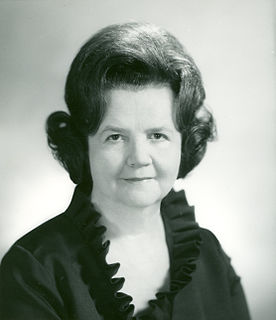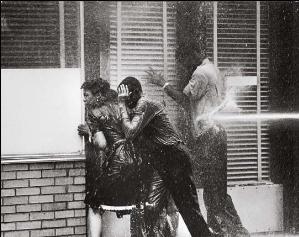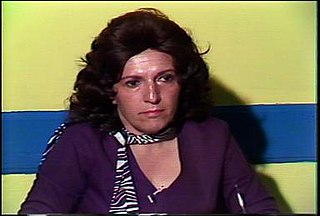Related Research Articles

The 1954–1968 civil rights movement in the United States was preceded by a decades-long campaign by African Americans and their like-minded allies to end legalized racial discrimination, disenfranchisement and racial segregation in the United States. The movement has its origins in the Reconstruction era during the late 19th century, although it made its largest legislative gains in the mid-1960s after years of direct actions and grassroots protests. The social movement's major nonviolent resistance and civil disobedience campaigns eventually secured new protections in federal law for the human rights of all Americans.

Anna Louise Day Hicks was an American politician and lawyer from Boston, Massachusetts, best known for her staunch opposition to desegregation in Boston public schools, and especially to court-ordered busing, in the 1960s and 1970s. A longtime member of Boston's school board and city council, she served one term in the United States House of Representatives, succeeding John William McCormack.

Race-integration busing in the United States was the practice of assigning and transporting students to schools within or outside their local school districts in an effort to diversify the racial make-up of schools. While the 1954 U.S. Supreme Court landmark decision in Brown v. Board of Education declared racial segregation in public schools unconstitutional, many American schools continue to remain largely uni-racial due to housing inequality. In an effort to address the ongoing de facto segregation in schools, the 1971 Supreme Court decision, Swann v. Charlotte-Mecklenburg Board of Education, ruled that the federal courts could use busing as a further integration tool to achieve racial balance.

John Frederick Collins was the Mayor of Boston, Massachusetts from 1960 to 1968. Collins was a lawyer who served in the Massachusetts Legislature from 1947–1955. He and his children caught polio during a 1955 outbreak; Collins was forced to use a wheelchair and crutches the rest of his life. After partially recovering, he ran for mayor in 1959 as an underdog; he successfully portrayed himself as outside corrupt "machine politics", and was elected.

Kevin Hagan White was an American politician best known as the Mayor of Boston, an office to which he was first elected at the age of 38, and which he held for four terms, amounting to 16 years, from 1968 to 1984. He presided as mayor during racially turbulent years in the late 1960s and 1970s, and the start of desegregation of schools via court-ordered busing of school children in Boston. White won the mayoral office in the 1967 general election in a hard-fought campaign opposing the anti-busing and anti-desegregation Boston School Committee member Louise Day Hicks. He was earlier elected Massachusetts Secretary of the Commonwealth in 1960 at the age of 31, and resigned from that office after his election as Mayor.

Restore Our Alienated Rights (ROAR) was an organization formed in Boston, Massachusetts by Louise Day Hicks in 1974. Opposed to desegregation busing of Boston's public school students, the group protested the federally-mandated order to integrate Boston Public Schools by staging formal, sometimes violent protests. It remained active from 1974 until 1976.

Segregation academies are private schools in the Southern United States that were founded in the mid-20th century by white parents to avoid having their children attend desegregated public schools. They were founded between 1954, when the U.S. Supreme Court ruled that segregated public schools were unconstitutional, and 1976, when the court ruled similarly about private schools.

The Birmingham campaign, also known as the Birmingham movement or Birmingham confrontation, was an American movement organized in early 1963 by the Southern Christian Leadership Conference (SCLC) to bring attention to the integration efforts of African Americans in Birmingham, Alabama.

Common Ground: A Turbulent Decade in the Lives of Three American Families is a nonfiction book by J. Anthony Lukas, published by Alfred A. Knopf in 1985, that examines race relations in Boston, Massachusetts, through the prism of desegregation busing. It received the Pulitzer Prize for General Nonfiction, the National Book Award for Nonfiction, and the National Book Critics Circle Award. The book traces the history of three families: the working-class African-American Twymons, the working-class Irish McGoffs, and the middle-class Yankee Divers. It gives brief genealogical histories of each families, focusing on how the events they went through illuminated Boston history, before narrowing its focus to the racial tension of the 1960s and the 1970s. Through their stories, Common Ground focuses on racial and class conflicts in two Boston neighborhoods: the working-class Irish-American enclave of Charlestown and the uneasily integrated South End.

Hyde Park High School was a four-year public high school that served students in ninth through twelfth grades in the Boston neighborhood of Hyde Park, Massachusetts, United States. The school held its first classes in 1869, one year after the founding of the town of Hyde Park. The school was located at 655 Metropolitan Avenue from 1928 until its closure in 2005.

Black schools, also referred to as "colored" schools, were racially segregated schools in the United States that originated after the American Civil War and Reconstruction era. The phenomenon began in the late 1860s during Reconstruction era when Southern states under biracial Republican governments created public schools for the ex enslaved. They were typically segregated. After 1877, conservative whites took control across the South. They continued the black schools, but at a much lower funding rate than white schools.
Morgan v. Hennigan was the case that defined the school busing controversy in Boston, Massachusetts during the 1970s. On March 14, 1972, the Boston chapter of the NAACP filed a class action lawsuit against the Boston School Committee on behalf of 14 black parents and 44 children. Tallulah Morgan headed the list of plaintiffs and James Hennigan then chair of the School Committee, was listed as the main defendant.
The desegregation of Boston public schools (1974–1988) was a period in which the Boston Public Schools were under court control to desegregate through a system of busing students. The call for desegregation and the first years of its implementation led to a series of racial protests and riots that brought national attention, particularly from 1974 to 1976. In response to the Massachusetts legislature's enactment of the 1965 Racial Imbalance Act, which ordered the state's public schools to desegregate, W. Arthur Garrity Jr. of the United States District Court for the District of Massachusetts laid out a plan for compulsory busing of students between predominantly white and black areas of the city. The hard control of the desegregation plan lasted for over a decade. It influenced Boston politics and contributed to demographic shifts of Boston's school-age population, leading to a decline of public-school enrollment and white flight to the suburbs. Full control of the desegregation plan was transferred to the Boston School Committee in 1988; in 2013 the busing system was replaced by one with dramatically reduced busing.

School segregation in the United States (US) is the separation of students based on their race to the extent that an institution can be racially predominant by black students or white students. Currently more than half of all students in the United States attend school distracts with high racial concentration and about 40% of black students attend schools where 90%-100% of students are non-white. School racial segregation is worst in the northeastern U.S.

School integration in the United States is the process of ending race-based segregation within American public and private schools. Racial segregation in schools existed throughout most of American history and remains an issue in contemporary education. During the Civil Rights Movement school integration became a priority, but since then de facto segregation has again become prevalent.
Jean McGuire was the first female African American to gain a seat on the Boston School Committee at Large, in 1981 during the Boston busing desegregation era. She also served as the executive director of the Metropolitan Council for Educational Opportunity since 1973. She grew up in Massachusetts and lived in Washington, D.C. during the 1930s and 1940s, when schools were mostly segregated and unequal.
This is a timeline of the 1947 to 1968 civil rights movement in the United States, a nonviolent mid-20th century freedom movement to gain legal equality and the enforcement of constitutional rights for People of Color. The goals of the movement included securing equal protection under the law, ending legally established racial discrimination, and gaining equal access to public facilities, education reform, fair housing, and the ability to vote.
Until 1950, African Americans were a small but historically important minority in Boston, where the population was majority white. Since then, Boston's demographics have changed due to factors such as immigration, white flight, and gentrification. According to census information for 2010–2014, an estimated 180,657 people in Boston are Black/African American, either alone or in combination with another race. Despite being in the minority, and despite having faced housing, educational, and other discrimination, African Americans in Boston have made significant contributions in the arts, politics, and business since colonial times.

Elvira "Pixie" Palladino was an American politician from Boston, Massachusetts, best known for her affiliation with Restore Our Alienated Rights (ROAR) and her opposition to court-ordered busing in the 1960s and 1970s. She was elected to the Boston School Committee several times in the 1970s, and served three two-year terms. Though she was cleared of bribery charges related to the Boston School Committee in 1981 this ultimately led to the loss of her Committee seat.
Prior to the civil rights movement in South Carolina, African Americans in the state had very few political rights. South Carolina briefly had a majority-black government during the Reconstruction era after the Civil War, but with the 1876 inauguration of Governor Wade Hampton III, a Democrat who supported the disenfranchisement of blacks, African Americans in South Carolina struggled to exercise their rights. Poll taxes, literacy tests, and intimidation kept African Americans from voting, and it was virtually impossible for someone to challenge the Democratic Party, which ran unopposed in most state elections for decades. By 1940, the voter registration provisions written into the 1895 constitution effectively limited African-American voters to 3,000—only 0.8 percent of those of voting age in the state.
References
- 1 2 3 4 5 6 7 8 Race and Racism in the United States: An Encyclopedia of the American Mosaic: An Encyclopedia of the American Mosaic. 2014. ISBN 1440803463.
- ↑ White, Deborah. Freedom on My Mind.
- 1 2 "Civil Rights Act (1964)".
- ↑ Formisano, Ronald (March 2009). "Is Boston Racist?". Boston Against Busing; Race, Class, and Ethnicity.